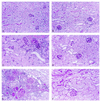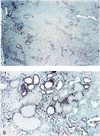The lack of a functional p21(WAF1/CIP1) gene ameliorates progression to chronic renal failure
- PMID: 10485911
- PMCID: PMC17968
- DOI: 10.1073/pnas.96.19.10830
The lack of a functional p21(WAF1/CIP1) gene ameliorates progression to chronic renal failure
Abstract
Partial renal ablation leads to progressive renal insufficiency and is a model of chronic renal failure from diverse causes. We find that mice develop functional and morphologic characteristics of chronic renal failure after partial renal ablation, including glomerular sclerosis, systemic hypertension, and reduced glomerular filtration. However, we now report that littermates with a homozygous deletion of the gene for the cyclin-dependent kinase inhibitor, p21(WAF1/CIP1), do not develop chronic renal failure after ablation. The markedly different reactions of the p21(+/+) and p21(-/-) animals was not because of differences in glomerular number or degree of renal growth but rather because of the presence or absence of a normal p21 gene. Although the reaction to the stress of renal ablation is both hyperplastic and hypertrophic in the presence of a functional p21 gene, it would appear that the absence of the p21 gene may induce a more hyperplastic reaction because proliferating-cell nuclear antigen expression, a marker of cell-cycle progression, in the renal epithelium of the remnant kidney was more than five times greater in the p21(-/-) mice than in the p21(+/+) animals. Because p21 is a potent inhibitor of the cell cycle, we speculate that p21 regulates the balance between hyperplasia and hypertrophy after renal ablation. We propose that this change in response inhibits the development of chronic renal failure. These studies suggest that controlling p21 function may ameliorate or even prevent progressive end-stage renal disease.
Figures






Comment in
-
Size does matter: will knockout of p21(WAF1/CIP1) save the kidney by limiting compensatory renal growth?Proc Natl Acad Sci U S A. 1999 Sep 14;96(19):10551-3. doi: 10.1073/pnas.96.19.10551. Proc Natl Acad Sci U S A. 1999. PMID: 10485857 Free PMC article. Review. No abstract available.
References
-
- Chanutin A, Ferris E B., Jr Arch Intern Med. 1932;49:767–787.
-
- Morrison A B. Lab Invest. 1962;11:321–332. - PubMed
-
- Faraj A H, Morley A R. APMIS. 1992;100:1097–1105. - PubMed
-
- Daniels B S, Hostetter T H. Am J Physiol. 1990;258:F1409–F1416. - PubMed
-
- Megyesi J, Udvarhelyi N, Safirstein R L, Price P M. Am J Physiol. 1996;271:F1211–F1216. - PubMed
Publication types
MeSH terms
Substances
Grants and funding
LinkOut - more resources
Full Text Sources
Other Literature Sources
Molecular Biology Databases

